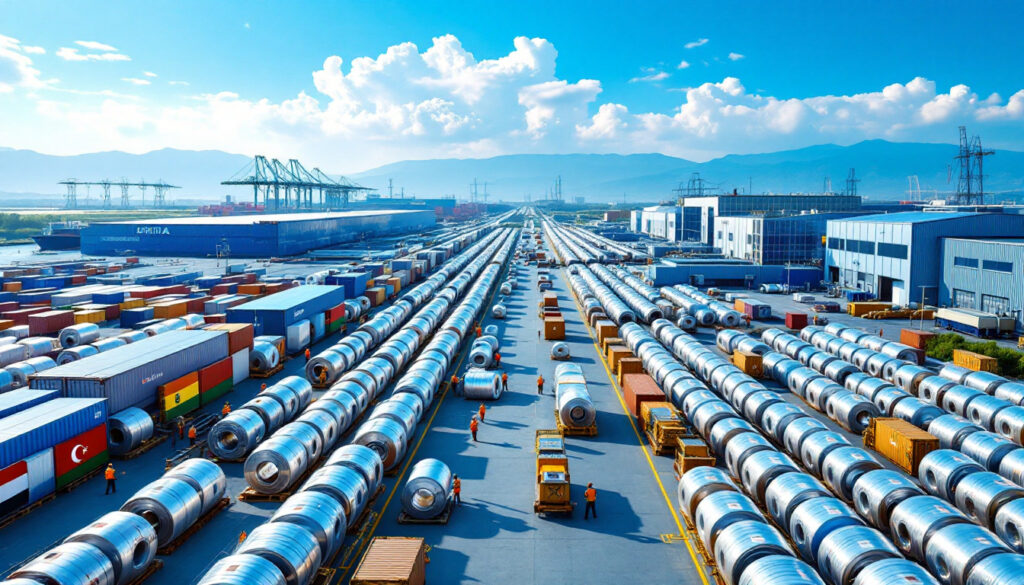China's Aluminum Wire and Cable Exports: 2025 Growth Analysis and Market Trends
China's aluminum wire and cable exports demonstrated remarkable growth in March 2025, with monthly volumes surging 47.2% month-on-month (MoM) to 22,500 metric tons (mt) and a 59.9% year-on-year (YoY) increase. Cumulative exports for the first quarter of 2025 reached 61,500 mt, reflecting a 19% YoY growth compared to the same period in 2024. This growth trajectory is underpinned by recovering domestic production capacities, robust demand from global infrastructure and renewable energy projects, and a structural shift toward aluminum as a cost-effective alternative to copper. Regional export patterns highlight Africa and South America as emerging markets, while Jiangsu Province dominates China's export landscape due to its advanced industrial infrastructure.
What Drove the 47.2% Monthly Growth in China's Aluminum Wire and Cable Exports?
March 2025 Export Performance Highlights
China's aluminum wire and cable exports in March 2025 reached 22,500 mt, marking a 47.2% MoM increase from February 2025 and a 59.9% YoY surge compared to March 2024. The first quarter of 2025 saw cumulative exports of 61,500 mt, a 19% YoY growth over Q1 2024. Notably, the single-month YoY growth rate outpaced the quarterly average by 40 percentage points, signaling accelerating demand as domestic manufacturers resumed full operations after seasonal slowdowns.
Key Growth Drivers
The rebound in exports was driven by three interrelated factors. First, overseas demand for aluminum wire and cable products remained robust, particularly in traditional power infrastructure and renewable energy sectors. Second, domestic enterprises completed post-Lunar New Year production recoveries, enabling increased output to meet international orders. Third, the seasonal lull in China's domestic demand during Q1 allowed manufacturers to prioritize export markets, amplifying monthly shipment volumes. Globally, the substitution of copper with aluminum in electrical applications gained momentum, driven by aluminum's cost advantages and comparable conductivity for specific uses.
How is China's Aluminum Wire and Cable Export Market Structured?
Product Composition Analysis
The export portfolio in March 2025 was evenly split between two product categories. Steel-core aluminum stranded wire accounted for 11,500 mt (51% of total exports), reflecting 4% MoM and 40% YoY growth. This product remains critical for traditional power grid projects, where its high tensile strength suits long-distance transmission lines. Meanwhile, aluminum stranded wire exports reached 11,000 mt (49% of total exports), surging 158% MoM and 87% YoY. This segment's explosive growth aligns with global investments in photovoltaic (PV) projects, where lightweight aluminum cables reduce installation costs and logistical burdens.
New Energy Market Penetration
The 87% YoY growth in aluminum stranded wire exports underscores its adoption in renewable energy infrastructure. Solar projects, in particular, favor aluminum due to its weight-to-conductivity ratio, which simplifies mounting on large-scale PV arrays. Additionally, aluminum's corrosion resistance enhances durability in coastal and arid environments, making it ideal for emerging markets in Africa and Southeast Asia. Furthermore, these characteristics have contributed significantly to reshaping commodity markets globally.
Where Are China's Aluminum Wire and Cable Exports Going?
Top Export Destinations in March 2025
China exported aluminum wire and cable products to 93 countries in March 2025, with African nations dominating shipments. Tunisia received 1,937.046 mt, followed by Ghana (1,781.23 mt) and Egypt (762.348 mt). These figures highlight Africa's focus on expanding power transmission networks to support urbanization and industrial growth. In South America, Bolivia (1,368.39 mt) and Paraguay (724.146 mt) emerged as growth markets, while Southeast Asian demand was led by Cambodia (787.112 mt) and the Philippines (697.295 mt).
Emerging Markets with Growth Potential
Africa's infrastructure deficit presents long-term opportunities. The continent's electrification rate remains below 50%, necessitating investments in grid expansion and decentralized renewable energy systems. Similarly, Southeast Asia's pursuit of solar and wind energy aligns with aluminum cable demand, particularly in off-grid and rural electrification projects. In fact, recent global commodities insights suggest these regions will continue to drive demand through 2027.
Which Chinese Provinces Lead in Aluminum Wire and Cable Exports?
Provincial Export Distribution
Jiangsu Province dominated exports with 8,919.8 mt (39.5% of the total), leveraging its advanced manufacturing ecosystem, including specialized logistics and R&D facilities. Henan Province followed with 4,756.8 mt (21.1%), supported by lower labor costs and proximity to raw material suppliers. By contrast, provinces like Hainan and Gansu recorded near-zero exports due to limited industrial infrastructure and logistical challenges.
Regional Disparity Factors
Coastal provinces benefit from established supply chains and ports, enabling efficient international shipments. Inland regions, such as Jiangxi and Hebei, face higher transportation costs and fragmented production networks, constraining their export capabilities. This disparity underscores the concentration of China's aluminum processing industry in economically developed eastern provinces.
What Are the Market Outlook and Future Trends?
Q2 2025 Export Projections
Export growth is expected to stabilize at elevated levels in Q2 2025, though domestic demand may divert some capacity as China's power grid projects approach completion deadlines. Aluminum stranded wire exports will likely remain strong due to sustained global PV investments, particularly in Europe and North America. Recent analysis of the global copper market suggests continued pressure on copper prices, further incentivizing aluminum adoption.
2025 Annual Forecast
Annual exports are projected to reach 200,000 mt, with potential to exceed 250,000 mt if copper prices remain high and substitution trends accelerate. The International Energy Agency (IEA) estimates that global renewable energy capacity must double by 2030 to meet climate targets, ensuring sustained demand for aluminum cables. Additionally, the ongoing commodity super cycle could further strengthen aluminum's market position.
Long-Term Market Drivers
The transition to renewable energy systems and grid modernization in developing economies will underpin aluminum cable demand. Additionally, innovations in aluminum alloy conductivity could expand its applications beyond low-voltage systems, challenging copper's dominance in high-performance sectors. According to recent industry reports, new aluminum alloys with enhanced conductivity properties are already being tested in commercial applications.
FAQ: China's Aluminum Wire and Cable Export Market
Why is aluminum wire replacing copper in global markets?
Aluminum offers a 60–70% cost advantage over copper while providing sufficient conductivity for power transmission. With copper price dynamics remaining volatile, utilities and contractors increasingly adopt aluminum for budget-sensitive projects.
What factors are driving growth in African market demand?
Africa's electrification initiatives, such as the African Union's Agenda 2063, prioritize grid expansion and renewable energy integration, necessitating imported cable solutions. China's competitive pricing and scalable production align with these needs.
How are new energy projects influencing exports?
Global PV installations require lightweight, durable cabling for cost-effective deployment. Aluminum's properties make it ideal for solar farms, driving an 87% YoY increase in related exports.
Which Chinese manufacturers lead the export market?
Jiangsu-based firms dominate due to integrated supply chains and technological expertise, though specific company data is not disclosed in public reports.
Disclaimer: This analysis is based on current market data and trends. Future performance may be affected by regulatory changes, economic conditions, and technological developments. Readers should conduct their own research before making business decisions.
Want to Invest in the Next Major Mineral Discovery?
Discover significant ASX mineral announcements in real-time with Discovery Alert's proprietary Discovery IQ model, transforming complex exploration data into actionable investment insights. Explore why major mineral discoveries can lead to exceptional market returns by visiting Discovery Alert's dedicated discoveries page and secure your 30-day free trial today.




